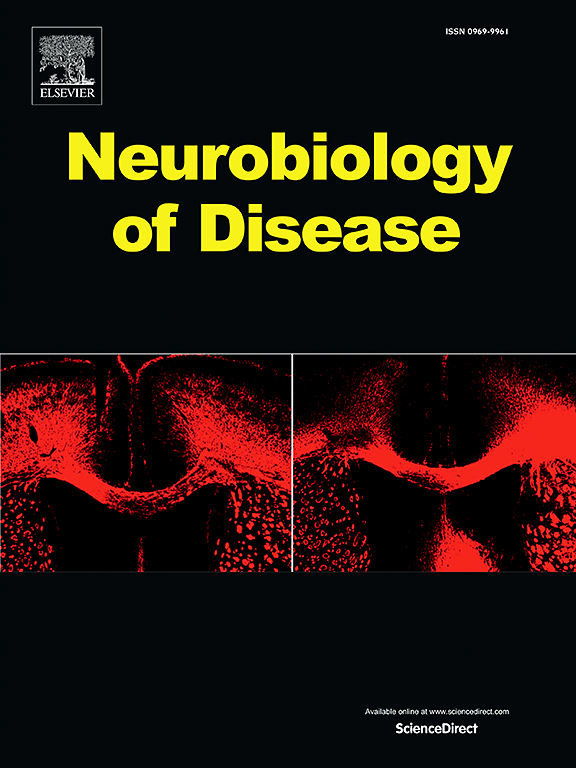受损的质膜钙atp酶活性和线粒体功能障碍有助于钙失调法布里病相关的疼痛性神经病变。
IF 5.6
2区 医学
Q1 NEUROSCIENCES
引用次数: 0
摘要
神经性疼痛是法布里病(FD)的标志性症状,法布里病是一种由α-半乳糖苷酶a (α-GalA)活性降低引起的遗传性x连锁溶酶体贮积症。α-GalA缺乏导致体液和包括感觉神经节在内的各种细胞类型的溶酶体中globotriaosylneuroide (Gb3)和globotriaosylsphingosine (lyso-Gb3)的逐渐积累。FD神经病变影响小而薄的有髓鞘的Aδ纤维和无髓鞘的C纤维,导致表皮内神经元末梢的丧失,以及热知觉和机械知觉的改变。脂质积累,如Gb3和溶索-Gb3,与各种细胞功能障碍有关,包括离子电流的改变。研究表明,将Gb3施用于人脐静脉内皮细胞会导致钙(Ca2+)激活的K+通道KCa3.1的下调,而lyso-Gb3则会引起细胞质内Ca2+瞬态和小鼠背根神经节中电压激活的Ca2+电流的增强。因此,我们通过α-Gal A(-/0)小鼠模型研究了Ca2+在初级传入神经元中的调节机制。这些结果表明,其他转运蛋白参与FD中Ca2+稳态,其功能障碍可能直接参与伤害感受。在这种情况下,质膜Ca2+ atp酶在FD中表现出活性降低,导致感觉神经元中静息[Ca2+]I增加。活性降低与胞质pH降低有关,从而减弱了pmca依赖性钙挤压。我们最后评估了线粒体对(Ca2+)信号传导的贡献,我们观察到线粒体缓冲能力的损伤,以及线粒体功能障碍和自噬/线粒体自噬增强。这些发现为进一步了解FD中神经病变症状发生的钙信号改变提供了基础。本文章由计算机程序翻译,如有差异,请以英文原文为准。
Impaired plasma membrane calcium ATPase activity and mitochondrial dysfunction contribute to calcium dysregulation in Fabry disease-related painful neuropathy
Neuropathic pain is a hallmark symptom in Fabry disease (FD), a hereditary X-linked lysosomal storage disorder caused by a reduced activity of α-galactosidase A (α-Gal A). The α-Gal A deficiency results in the progressive accumulation of globotriaosylceramide (Gb3) and globotriaosylsphingosine (lyso-Gb3) in the body fluids and lysosomes of various cell types, including sensory ganglia. The FD neuropathy affects the small thinly myelinated Aδ fibers and unmyelinated C fibers leading to the loss of intra-epidermal neuronal terminations, along with altered thermal and mechanical perception. Lipid accumulation, such as Gb3 and lyso-Gb3, is implicated in various cellular dysfunctions, including the alteration of ionic currents. It has been shown that administration of Gb3 to human umbilical vein endothelial cells leads to the downregulation of the calcium (Ca2+)-activated K+ channel KCa3.1, whereas lyso-Gb3 evokes cytosolic Ca2+ transients and an enhancement of voltage-activated Ca2+ currents in murine dorsal root ganglia. Therefore, we examined the mechanism underlying Ca2+ regulation in primary afferent neurons from the α-Gal A (−/0) mouse model. The obtained results suggest that other transport proteins participate in Ca2+ homeostasis in FD and their dysfunction may be directly involved in nociception. In this context, plasma-membrane Ca2+ ATPases exhibited reduced activity in FD, leading to an increased resting [Ca2+]i in sensory neurons. The reduced activity was associated with a decrease of cytosolic pH which weakened the PMCA-dependent calcium extrusion. We finally evaluated the contribution of mitochondria to the Ca2+ signalling and we observed impairment of the mitochondrial buffer capacity, as well as dysfunctional mitochondria and enhanced autophagy/mitophagy. These findings provide a basis for future insights into the alterations of calcium signalling underlying the onset of neuropathic symptoms in FD.
求助全文
通过发布文献求助,成功后即可免费获取论文全文。
去求助
来源期刊

Neurobiology of Disease
医学-神经科学
CiteScore
11.20
自引率
3.30%
发文量
270
审稿时长
76 days
期刊介绍:
Neurobiology of Disease is a major international journal at the interface between basic and clinical neuroscience. The journal provides a forum for the publication of top quality research papers on: molecular and cellular definitions of disease mechanisms, the neural systems and underpinning behavioral disorders, the genetics of inherited neurological and psychiatric diseases, nervous system aging, and findings relevant to the development of new therapies.
 求助内容:
求助内容: 应助结果提醒方式:
应助结果提醒方式:


